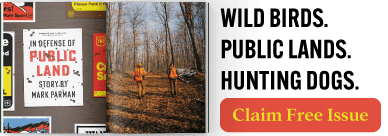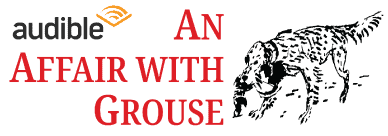Home » Conservation » The Extinction of the Passenger Pigeon
The Extinction of the Passenger Pigeon
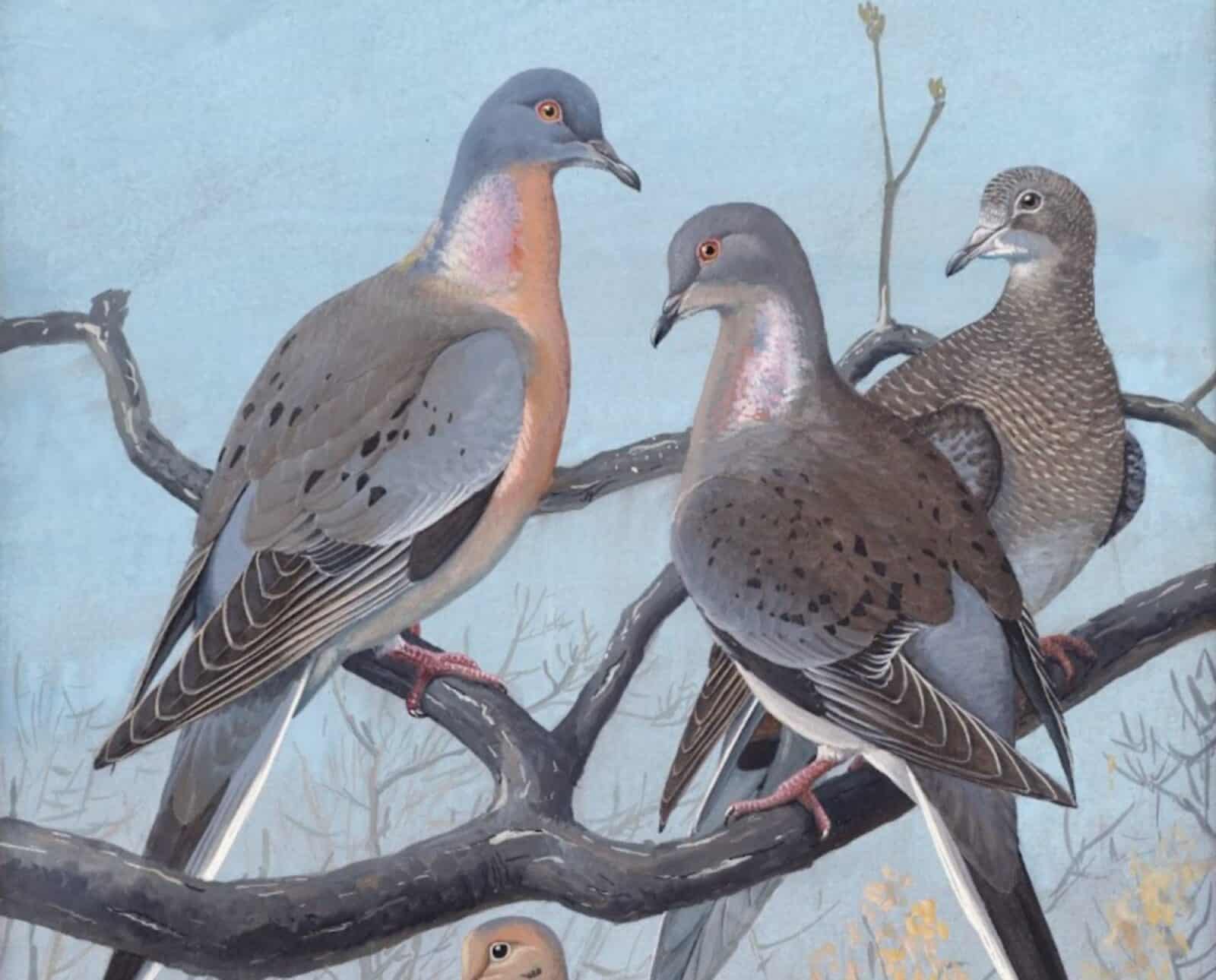
A.J. DeRosa, founder of Project Upland, is a New England…
The Mysterious Disappearance of a Wandering Migrant
This article originally appeared in the spring 2025 issue of Project Upland Magazine.
Each day, as I leave the New Hampshire Fish and Game Headquarters in Concord, I make a point to visit a glass case. There, in the bottom corner, rests a mounted specimen of a passenger pigeon. It exists subtly, rarely noticed by passersby. That specimen inspired me to attempt to understand the conservation mystery of the passenger pigeon’s extinction.
The loss of the passenger pigeon is one of the most shocking extinction stories in the Americas. It is both mysterious and a dark reminder of the profound impact humans have on the landscape.
If you lived in North America before the twentieth century, you might have experienced a flock of migrating passenger pigeons. During migration events, the sound of the birds was overwhelming. The sky darkened as their bodies, each weighing just under a pound, blocked the sun. For days, passenger pigeon droppings fell from the sky like snow. Thus, it came as a great shock when the species went extinct in the wild in 1900. Just fourteen years later, Martha, the last and most famous passenger pigeon, born in captivity, died at the age of twenty-nine in the Cincinnati Zoo.
While reading 1491: New Revelations of the Americas Before Columbus by Charles C. Mann, I was fascinated by its exploration of the landscape management practices of Indigenous peoples. The book explains how colonizers mistook the “Garden of Eden” they “discovered” as a natural phenomenon rather than the result of long-term human management. It also contains a few pages on the archaeological record of the passenger pigeon.
Mann describes a theory suggesting that Indigenous peoples controlled the passenger pigeon population. According to this theory, the massive decline in North America’s Indigenous population due to post-colonization diseases led to an overpopulation of passenger pigeons.
It’s a rather shocking theory—and a debated one as well. These peculiarities only deepened my curiosity. What biological impacts did the passenger pigeon have on the broader ecological system of North America? What was it like to witness the incredible scenes created by their vast populations? And, most importantly, why did the passenger pigeon go extinct?
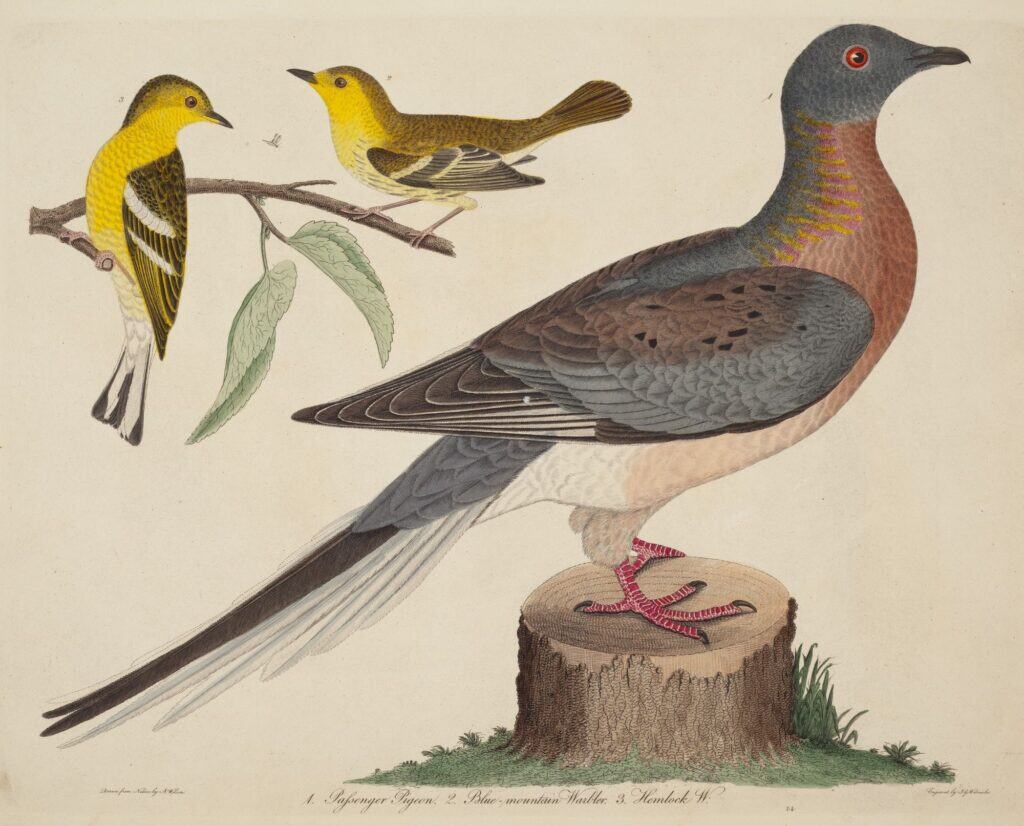
Passenger Pigeon Biology
A Message from Martha by Mark Avery is a book fully dedicated to the passenger pigeon. From a biological perspective, Avery does an excellent job of highlighting key facts about this bird, often referred to as the “Blue Meteor.”
Avery explains that the passenger pigeon weighed approximately twelve ounces and measured about sixteen inches in length, with males being slightly larger than females. In his book, Avery includes one of John Muir’s personal accounts describing the bird and its plumage:
The breast of the male is a fine rosy red, the lower part of the neck behind and along the sides changing from the red of the breast to gold, emerald green and rich crimson. The general color of the upper parts is grayish blue, the under parts white. The extreme length of the bird is about seventeen inches; the finely modeled slender tail about eight inches, and extent of wings twenty four inches. The females are scarcely less beautiful… every color just like the wonderful wood ducks.
The range of the passenger pigeon closely mirrored that of the American woodcock, migrating from the northern parts of the eastern and central United States and Canada to the southern regions during the winter months. Their primary food source was tree mast, and their range reflected this.
“This range reflects the distribution of the American beech, red oak, white oak, and American chestnut trees—the most important sources of food for the passenger pigeon,” wrote Avery. While tree mast was the pigeon’s primary food source, they also foraged for other foods, including wild rice, berries, and invertebrates.
The passenger pigeon’s Latin name, Ectopistes migratorius, translates to “wandering migrant,” aptly describing their behavior. These birds relied heavily on tree mast, and their movements were dictated by food availability rather than strictly by seasonal migration. This behavior highlights a critical aspect of their ecology: flocks of millions relocated to areas with sufficient food supplies. Remarkably, the pigeons remembered locations with abundant tree crops from previous years and sought out areas where melting snow exposed springtime food resources.
The bird’s strong memory and proclivity to move to areas with high food densities often resulted in crops stuffed with feed. “There are accounts of birds with crops as large as oranges because they were so filled with food,” wrote Avery. In addition to being opportunistic eaters, passenger pigeons would regurgitate the contents of their crops if they found a more desirable food.
The Dilution Effect
To understand a key aspect of the mystery surrounding the extinct passenger pigeon, the “dilution effect” as a survival strategy must be considered. Simply put, individual birds had no significant defense against predators. Instead, they relied on their overwhelming numbers for protection. As Avery elegantly put it, “For a passenger pigeon to make the most of the arithmetic of the dilution effect, it still wanted to just be one in the crowd—preferably one of the middle crowd.”
One of the most famous accounts of the passenger pigeon comes from John James Audubon. After witnessing a nesting site in Kentucky, he wrote:
The dung lay several inches deep, covering the whole extent of the roosting place, like a bed of snow. Many trees two feet in diameter, I observed, were broken off at no great distance from the ground; and the branches of many of the largest and tallest had given way, as if the forest had been swept by a tornado. Everything proved to me that the number of birds resorting to this part of the forest must be immense beyond conception…The howlings of the wolves now reached our ears, and the foxes, lynxes, cougars, bears, raccoons, opossums, and pole-cats were seen sneaking off, whilst eagles and hawks of different species, accompanied by a crowd of vultures, came to supplant them and enjoy their share of the spoil.
The passenger pigeon’s reliance on large numbers for survival was evident in nearly every aspect of its behavior, including its breeding habits. A single adult passenger pigeon nested in multiple states throughout its life—an important biological detail in unraveling the mystery of their extinction. In each colony, the birds nested simultaneously, a phenomenon Avery described as “extreme synchrony of nesting within colonies.”
Nesting was a competitive race, with birds vying for spots deeper within the colony, where they were safer from predators. This behavior further amplified the dilution effect, reducing the likelihood of any individual bird being targeted by predators.
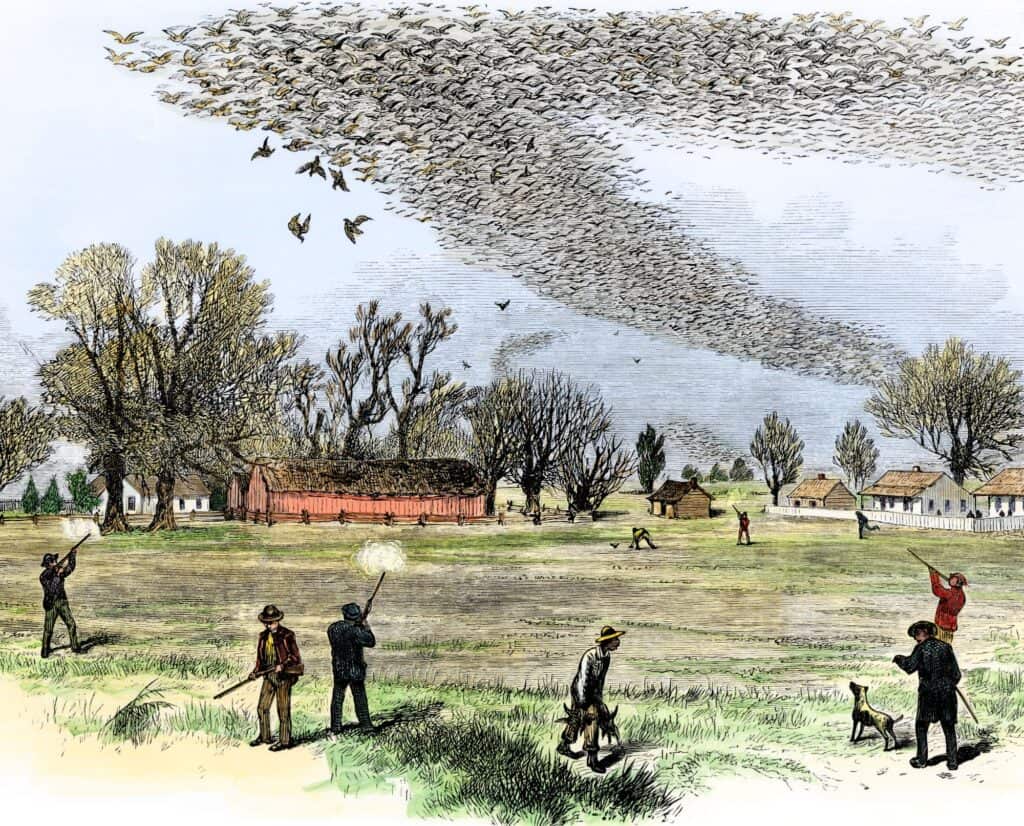
Passenger Pigeon Breeding Behaviors
One of the most fervent debates surrounding the passenger pigeon, revisited time and again, concerns how the species reproduced to maintain or grow its population. Central to this debate is the use of reverse-engineered mathematical models to predict population dynamics. In the case of the passenger pigeon, the difference between laying one or two eggs could profoundly influence our understanding of their population decline.
A. W. Schorger’s The Passenger Pigeon: Its History and Extinction, published in 1973, remains a cornerstone of research on the species. Schorger meticulously dissected eyewitness accounts of nesting sites, some stretching up to thirty miles long and five miles wide. His work provided invaluable insights into nesting behavior, drawing from extensive firsthand descriptions. Nearly every book on the passenger pigeon published since has relied on the detailed accounts Schorger compiled.
The most compelling debate related to nesting behavior concerns whether passenger pigeons laid one or two eggs. While the one-egg theory has garnered the most support, Avery explores the two-egg theory in significant detail.
Avery’s first piece of biological evidence for the two-egg theory is the behavior of similar species. “Mourning doves, stock doves, wood pigeons, turtle doves, and collared doves all lay a clutch of two,” he wrote. Avery also considered established facts about the stock dove:
Our 50 pairs of Passenger Pigeons would, if Schorger is right, have laid 50 eggs. If we assume that they all hatched (which is very unlikely, given infertility, predation and harmful events such as late snowfalls) and all fledged (which is even more unlikely, what with predation and the food running out), then (given 40% first year survival like the Stock Dove) only 20 of them would enter the breeding population, and we need there to be 45 of them to balance the books. That is a chasm of a difference – instead of having 100 Passenger Pigeons the next year we only have 75.
Something doesn’t add up here, and I’ve checked my sums, so it’s not me! And that’s why we have a conundrum.
Schorger theorized that passenger pigeons may have nested multiple times a year, a hypothesis supported by ecologist Enrique Bucher in a 1992 research paper.
Another theory that could explain the pigeon’s population maintenance suggests that the species had unusually high adult survival rates.
Passenger Pigeons and Indigenous Peoples
My ancestors, the Mi’kmaq, would have cherished the springtime arrival of the passenger pigeon (Ples). It was a source of sustenance, hunted to provide a great bounty at the end of a long winter. Ples is also a constellation that chases the bear (Muin) across the sky. It is represented by the star Seginus, or Gamma Boötis, which returns each spring and summer as part of the constellation Boötes.
The passenger pigeon held cultural significance for many Indigenous peoples. In Joel Greenberg’s A Feathered River Across the Sky, he explores the Seneca’s history with the passenger pigeon, or jah’gowa, which means “big bread.” Greenberg quotes Willie Gordon, a descendant of Seneca Chief Cornplanter, who stated, “We will be fat eating squabs and drinking pigeon oil.” Much like bear fat, pigeon oil was critical for human winter survival. Greenberg also cites an account from John Lawson in 1700, who described: “You may find several Indian Towns, of not above 17 Houses, that have more than 100 Gallons of Pigeons Oil, or Fat; they use it with Pulse, or Bread, as we do Butter.”
According to Greenberg, passenger pigeon remains have been found in settlements as old as 10,000 B.C. Hunting these birds was closely tied to their nesting activity. During their short egg-laying window, Indigenous communities gathered for large hunting events involving both children and adults. Methods included the use of bows and arrows, nets, poles, and even clubs.
Interestingly, it is believed that tribes would not have looked kindly on the hunting of adult birds in nesting sites before the chicks hatched. An 1842 report that observed the Sioux noted, “The Indians never disturbed pigeons or ducks by shooting at them when nesting, and that the life of a man doing so would not be safe among the Sioux.” This reflects a conservation ethic grounded in reciprocity and respect for natural cycles.
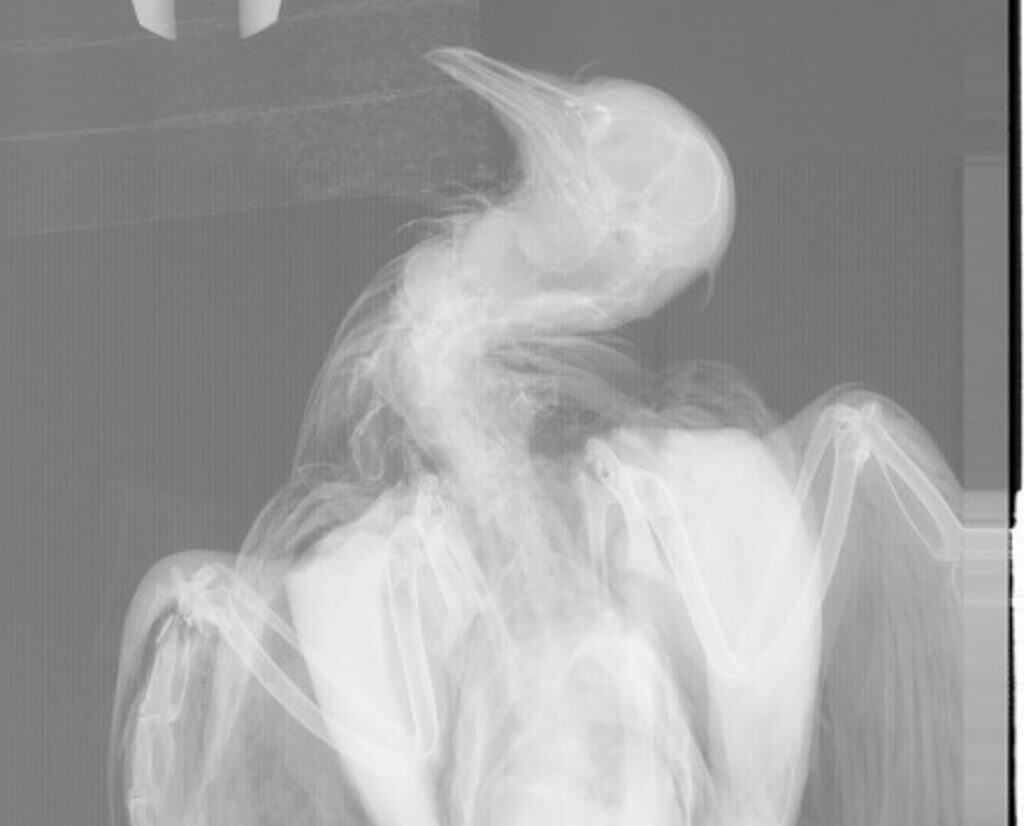
What Led to the Extinction of the Passenger Pigeon?
Many questions remain about how passenger pigeons existed before Columbus. Their ecological record is a subject of intense debate, with Greenberg and Mann presenting differing views. Mann summarizes the conclusions of archaeologist Thomas Neumann: “The conclusion was obvious: Passenger pigeons were not as numerous before Columbus. ‘What happened was that the impact of European contact altered the ecological dynamics in such a way that the Passenger Pigeon population exploded.’ The avian throngs Audubon saw were ‘outbreak populations—always a symptom of an extraordinarily disrupted ecological system.’”
If true, the overpopulation of passenger pigeons could have set the stage for an ecological overshoot. More specifically, this situation involved the combined demands of these birds and the arrival of colonizers, which exceeded the regenerative capacity of forested ecosystems.
What is most intriguing about the final chapter of the passenger pigeon’s history is its seemingly abrupt disappearance. While there is no doubt that human exploitation through market hunting played a role, Greenberg wrote, “I have struggled to accept as sufficient the purported factors that reduced a billion or more birds to zero in four decades. This abruptness led to the fanciful explanations advanced during the early twentieth century and has long left others feeling unsatisfied.”
One of the most imaginative theories regarding the extinction of the last passenger pigeon populations appears in William Mershon’s 1907 book The Passenger Pigeon. In the chapter titled “A Novel Theory of Extinction,” Mershon suggests that the last flocks flew out into the ocean (or the Great Lakes) in search of food and nesting grounds, ultimately perishing there. This theory is not accepted today.
Although I am by no means an expert on this topic, it seems that these books collectively tell a long story that begins in 1492. It is now widely accepted that Indigenous populations were far larger than early historical accounts indicate. Diseases brought by colonizers decimated Indigenous populations to such an extent that their ecological impact, including hunting passenger pigeons, went unchecked. Passenger pigeons persisted for over a century before significant colonization brought larger human populations back into these ecosystems.
Colonizers introduced market hunting and brought widespread deforestation. With the expansion of railroads, market hunting activities intensified, leading to even more aggressive exploitation of wildlife.
The last known passenger pigeon nesting sites were in the few remaining old-growth forests. These birds relied on mast from mature trees, but as logging reduced the number of such trees, their food sources dwindled. The loss of forests also increased the volatility of mast production. Avery noted, “States such as Ohio would have been very largely covered with forests at the time of the European invasion (around 95%); it was only 54% forest in 1853, 18% in 1883, and by 1900 only about 10% of the state was forested.
As the pigeon population decreased, its “dilution effect” survival strategy became less effective and ultimately dangerous. Some speculate that, like their Indigenous neighbors, the birds may have been affected by diseases introduced by non-native species, particularly given their tendency to form dense colonies.
Greenberg notes that by the 1870s, passenger pigeons had begun abandoning their nesting sites. He wrote, “With the ever-increasing intensity of exploitation, the birds became less tolerant of disturbance and quicker to give up their breeding aspirations.” As forests vanished, the availability of suitable nesting and wintering locations dwindled. This scarcity increased the pigeons’ vulnerability to predation; with fewer places to go, their movements became more predictable.
A Stark Reminder
The extinction of the passenger pigeon serves as a stark reminder of the intricate interconnections within ecosystems and the potentially devastating impact of human activity on these delicate balances. Despite our desire for simple explanations, the dynamics of biodiversity and ecology are complex. They encompass a myriad of factors that can trigger cascading effects beyond comprehension.
What else have we lost because of the extinction of the passenger pigeon? What types of habitat did their disturbances create? To what extent did their droppings fertilize forests? How have other species been impacted by the loss of such a historically abundant bird? These are questions to which we will likely never have definitive answers.
The story of the passenger pigeon stands as a poignant reminder of the importance of environmental stewardship. We must relearn how to participate in natural systems rather than destroy them.
As A. W. Schorger so aptly put it, “This species became extinct through the avarice and thoughtlessness of man.”
A.J. DeRosa, founder of Project Upland, is a New England native with over 35 years of hunting experience across three continents. His passion for upland birds and side-by-side shotguns has taken him around the world, uncovering the stories of people and places connected to the uplands. First published in 2004, he wrote The Urban Deer Complex in 2014 and soon discovered a love for filmmaking, which led to the award-winning Project Upland film series. A.J.'s dedication to wildlife drives his advocacy for conservation policy and habitat funding at both federal and state levels. He serves as Vice Chair of the New Hampshire Fish & Game Commission, giving back to his community. You can often find A.J. and his Wirehaired Pointing Griffon, Grim, hunting in the mountains of New England—or wherever the birds lead them.

